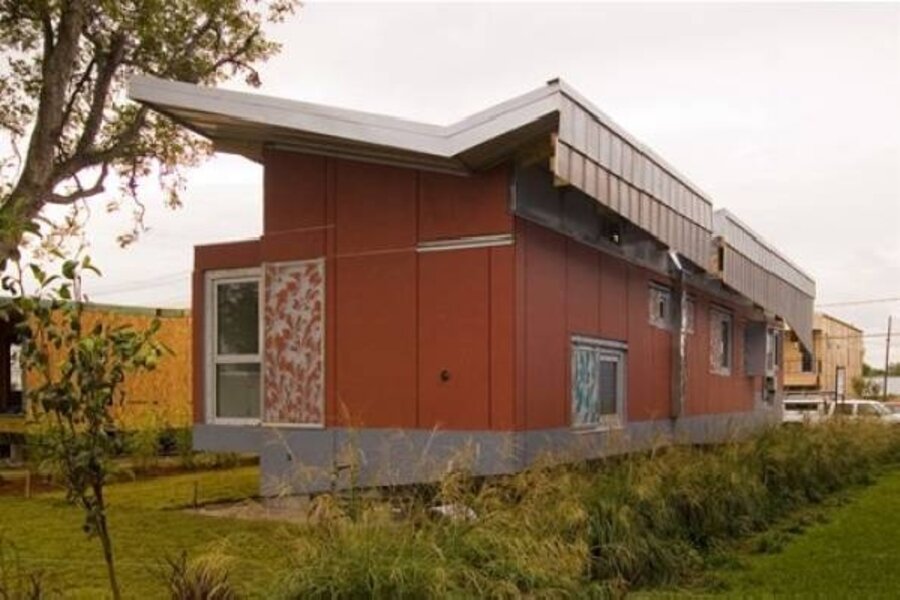Floating house could ride New Orleans' floods
Loading...
| NEW ORLEANS
A house capable of floating atop rising floodwaters made its debut Tuesday in New Orleans alongside more than a dozen other homes built through actor Brad Pitt's Make It Right Foundation.
Called the FLOAT House, the unique home aims to answer the challenge posed by the Big Easy's flood risk, starkly illustrated by the rising waters of Hurricane Katrina in 2005.
"I wanted to float it down the Mississippi River to New Orleans," architect Thom Mayne says with a chuckle while in New Orleans for Tuesday's event. Instead, the home was shipped in pieces from Los Angeles, where it had been constructed on UCLA's campus.
The dwelling was designed by Morphosis Architects under the direction of Mr. Mayne, a professor at UCLA. Mayne said it's the first of its kind to be permitted in the United States.
It is long and narrow like the traditional New Orleans shotgun home and sits on a raised 4-foot base. It also has a front porch. But the home is contemporary in design, with sharp angles and energy efficient features like solar panels and a roof designed to capture and recycle water.
"You have to build a house for the environment, for the reoccurrence of hurricanes, but it can also be energy efficient," Mayne says.
No one lives there yet, but a family could buy the home and move in as early as next month, says Tom Darden, executive director of Make It Right. The group says it went through the local zoning and permitting channels before erecting the 1,000 square-foot, two-bedroom house on the site.
Residents must qualify through the foundation to be eligible for the floating house or other homes being built by Pitt's group. They must have lived in the Lower 9th Ward before Hurricane Katrina struck the area in August 2005.
Mayne says the Morphosis floating house technology was developed and is in use in the Netherlands, where architects are working to address rising sea levels expected with climate change.
In case of a flood, the base of the house acts as a raft, allowing the home to rise on guide posts up to 12 feet as water levels rise. In the Lower 9th Ward, which saw some of the worst flooding in the city during Katrina, floodwater reached as high as 12 feet.
"It's amazing," Mr. Darden says. "Our goal is to be as innovative and eco-friendly as we can be, and the FLOAT House is certainly technology designed for this climate."
The home's base is a high-performance chassis made from polystyrene foam coated in glass fiber-reinforced concrete. It houses the essential equipment to supply power, water and fresh air.
While not intended for occupants to remain inside during a hurricane, the structure is designed to minimize catastrophic damage and preserve the homeowner's investment, Mayne says.
The floating home should also allow residents to return within days of a hurricane or flood, Mayne says.
Mayne's team, which included architects and UCLA graduate students, took about two years to design and build the house. He says he is now shopping for a production company to help mass produce it. Miller says the houses could sell for around $150,000.
Shannon Sharpe Briand, a New Orleans real estate agent with ReMax for more than seven years, says she thinks some buyers would be interested in the floating homes, especially if the going price is $150,000.
"That price is affordable, especially if the homes are move-in ready," she says.
Mayne said he admires Pitt's effort to build stronger, safer and more energy-efficient housing in New Orleans. Pitt founded Make It Right in 2007 to help Lower 9th Ward residents who lost their homes during Katrina.
More than a dozen homes have been completed — with families moved in — on the Make It Right site, and another 20 are under construction. Plans call for 50 homes on the site by December and 150 by the end of next year, Darden says.
Editor’s note: For more articles about the environment, see the Monitor’s main environment page, which offers information on many environment topics. Also, check out our Bright Green blog archive and our RSS feed.





